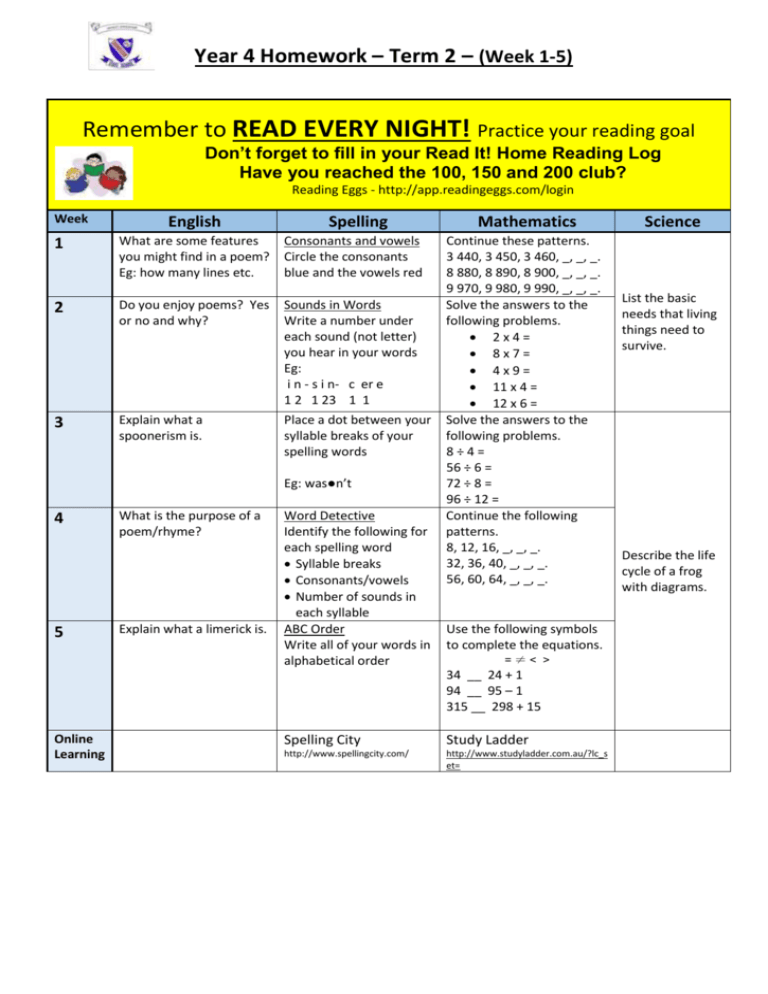Year 4 Group 5
advertisement

Year 4 Homework – Term 2 – (Week 1-5) Remember to READ EVERY NIGHT! Practice your reading goal Don’t forget to fill in your Read It! Home Reading Log Have you reached the 100, 150 and 200 club? Reading Eggs - http://app.readingeggs.com/login Week English Spelling 1 What are some features you might find in a poem? Eg: how many lines etc. Consonants and vowels Circle the consonants blue and the vowels red 2 Do you enjoy poems? Yes or no and why? Sounds in Words Write a number under each sound (not letter) you hear in your words Eg: i n - s i n- c er e 1 2 1 23 1 1 3 Explain what a spoonerism is. Place a dot between your syllable breaks of your spelling words Eg: was●n’t 4 5 What is the purpose of a poem/rhyme? Explain what a limerick is. Word Detective Identify the following for each spelling word Syllable breaks Consonants/vowels Number of sounds in each syllable ABC Order Write all of your words in alphabetical order Mathematics Continue these patterns. 3 440, 3 450, 3 460, _, _, _. 8 880, 8 890, 8 900, _, _, _. 9 970, 9 980, 9 990, _, _, _. Solve the answers to the following problems. 2x4= 8x7= 4x9= 11 x 4 = 12 x 6 = Solve the answers to the following problems. 8÷4= 56 ÷ 6 = 72 ÷ 8 = 96 ÷ 12 = Continue the following patterns. 8, 12, 16, _, _, _. 32, 36, 40, _, _, _. 56, 60, 64, _, _, _. Use the following symbols to complete the equations. =≠< > 34 __ 24 + 1 94 __ 95 – 1 315 __ 298 + 15 Online Learning Spelling City Study Ladder http://www.spellingcity.com/ http://www.studyladder.com.au/?lc_s et= Science List the basic needs that living things need to survive. Describe the life cycle of a frog with diagrams. Group 5 Derivational relations - Bases or roots Sort 34- 43 Term 2 Weeks 1-10 Facilitator ____________________ Chapter V, VI, VII: Greek and Latin Elements I can use words with Greek and Latin elements Chapter V, VI, VII: Greek and Latin Elements I can use words with Greek and Latin elements Chapter V, VI, VII: Greek and Latin Elements I can use words with Greek and Latin elements Chapter V, VI, VII: Greek and Latin Elements I can use words with Greek and Latin elements Chapter V, VI, VII: Greek and Latin Elements I can use words with Greek and Latin elements Sort 34 - Latin roots, man, script, Sort 34 - Latin roots, scrib, cred, fac Sort 35 - Latin roots duc, duct, seq, sec, Sort 35 - Latin roots flu, ver, vert Sort 36 - Latin roots prefixes, ante, post manual manufacture manicure manoeuvre manure manuscript mandate transcribe inscribe scribble scribe prescribe introduction conductor deduct abduct induce reduce educate inverse vertigo conversation convert extravert reverse antebellum ante meridian anterior antedate prescription inscription subscription Focus Rules man – hand scrib/script – to write cred- to believe words ending in ‘be’ change spelling when adding -ion WORD STUDY check dictionary for each base word create own meanings construct lists of other words– refer to additional words in Derivational Relations text Affixes – refer to previously taught prefix/suffixes Plurals S is usually used to make words plural ‘es’ is used for words ending with s, ss, x, sh ch & tch Tense verbs Add ‘ed’ & ‘ing’ suffix factory facilitate artefact facsimile discredit incredible credible credence incredulous Focus Rules scrib/script – to write cred- to believe fac – to make words ending in ‘be’ change spelling when adding -ion WORD STUDY check dictionary for each base word create own meanings construct lists of other words– refer to additional words in Derivational Relations text Affixes – refer to previously taught prefix/suffixes Plurals S is usually used to make words plural ‘es’ is used for words ending with s, ss, x, sh ch & tch Tense verbs Add ‘ed’ & ‘ing’ suffix sequel subsequent sect consecutive consequence Focus Rules duc/duct – lead sequ/sec – follow WORD STUDY check dictionary for each base word create own meanings construct lists of other words– refer to additional words in Derivational Relations text Affixes – refer to previously taught prefix/suffixes Plurals S is usually used to make words plural ‘es’ is used for words ending with s, ss, x, sh ch & tch Tense verbs Add ‘ed’ & ‘ing’ suffix fluid fluent superfluous influx fluctuate affluence Focus Rules flu – flow ver/vert - turn WORD STUDY check dictionary for each base word create own meanings construct lists of other words– refer to additional words in Derivational Relations text Affixes – refer to previously taught prefix/suffixes Plurals S is usually used to make words plural ‘es’ is used for words ending with s, ss, x, sh ch & tch Tense verbs Add ‘ed’ & ‘ing’ suffix postpone post meridian postbellum postmortem postscript posterior Focus Rules ante – before post- after WORD STUDY check dictionary for each base word create own meanings construct lists of other words– refer to additional words in Derivational Relations text Affixes – refer to previously taught prefix/suffixes Plurals S is usually used to make words plural ‘es’ is used for words ending with s, ss, x, sh ch & tch Tense verbs Add ‘ed’ & ‘ing’ suffix









